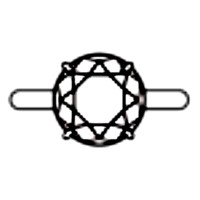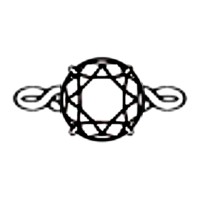Ring types
Rings can also be distinguished by their design and purpose.
The most common types are described below.
Types of gemstone rings by shape and design











Types of rings according to their intended use
Engagement ring
A proposal ring is usually a single-stone solitaire ring, but of course there can be several stone versions, or even a ring without stones, according to individual taste. In terms of material, engagement rings have been made from almost every material throughout history, but nowadays it is mostly precious metal rings that are used for this purpose. Sometimes the engagement is done with a wedding ring. If it is a traditional ring without a gemstone, it is customary to give a wedding band to accompany it. This is usually some kind of gem-set ring that goes well with the wedding band. As this is worn on the same finger as the wedding band, it is advisable to choose a thinner type for this purpose.
Check out our engagement ring selection by clicking here!
Wedding ring
The couple who are getting married usually choose the ring they both like together and put it on their hands at the wedding. The wedding ring is worn on the ring finger of the right hand after the wedding, but it is also sometimes the case that the engagement is celebrated with the wedding ring, in which case it is worn on the ring finger of the left hand until the wedding. The hoop rings were usually stone-free rings (two identical rings in a pair), which ladies wore with an accompanying ring, but more recently, gemstone versions of the hoop rings have come into fashion. These are the stone versions of the man's gemless wedding band. You could say that the wedding ring and the wedding band are now one.
Check out our wedding ring selection by clicking here!
Companion ring
Sometimes the engagement is done with a wedding ring. If it is a traditional ring without a gemstone, it is customary to give a wedding band to accompany it. This is usually some kind of gem-set ring that goes well with the wedding band. As this is worn on the same finger as the wedding band, it is advisable to choose a thinner type for this purpose.
Check out our companion ring selection by clicking here!
Signet ring
The signet ring was already common in the Middle Ages. Usually inherited through families, it was used to authenticate documents dipped in wax. Monograms and mirror images of family crests were engraved on them, so that the seal wax, once the seal ring was pressed in, would show the original image. The signet ring is the most popular piece of jewellery among men. Even today, some kind of monogram or logo is usually engraved or engraved on them, but they are not engraved very deeply anymore, as their original purpose of being used for wax seals has been lost. Therefore, they no longer engrave the reflection.
Check out our signet ring selection by clicking here!
Friendship ring
Many different rings can be used as friendship rings. It often happens that a couple in love decide to wear a wedding band as a friendship ring. They also often use custom engravings on the rings with texts and dates that refer to each other.
Claddagh ring
This is the name given to the friendship ring in Irish. The first ring of this kind was made in the late 1600s.
Class ring
These are the rings most often worn by alumni to commemorate the fact that they were once students themselves.
Memorial ring
Memorial rings are usually offered to commemorate an event. Many institutions and cities have a commemorative ring. A memorial ring is usually named after a person.
Cocktail ring
This category includes rings that are decorated with large, huge stones. They are worn for parties and soirees.
Gimmal ring
This ring is made up of three or more interlaced rings. Its name is of Latin origin and it spread in Europe in the 16th and 17th centuries. Martin Luther wore a ring like this at his wedding.
Championship ring
The championship ring is worn by members of a team after winning a sporting event. This is usually common in the United States.
Multi- finger ring
As the name suggests, such jewellery is worn on several fingers, not one. They can be worn on two or even three fingers and are often decorated with inscriptions.
Magical rings
This includes rings that are believed to have magical, enchanting powers.
Mood ring
This is a ring that changes colour to match the mood of the wearer. This type of ring first appeared in the 20th century.
Mourning ring
Mourning rings were usually rings decorated with black stones. The wearer wore it to commemorate the person for whom it was worn. This type of jewellery really took off in the Victorian era. There were many instances of a small lock of the deceased person's hair being placed in the ring and worn as such.
Talisman ring
Talisman rings have played a very important role in people's lives. Talisman rings brought good luck to the wearer and were said to have magical powers.
Watch ring
The watch rings served not only as a ring, but also as a watch. A special feature was that they were worn on the fingers.
Jeans ring
As the name suggests, it is made from jeans. This type of ring first appeared in the East, in Japan. Here, jeans was used in combination with silver to make jewellery. These jewels were decorated with precious and semi-precious stones. Although they have been in use since the end of the 20th century, such jewellery has not yet really spread to Europe.
Archers' ring
This was used by archers to prevent their fingers from getting hurt when they strung their bows.
Poison ring
These rings were also common in the Middle Ages. From a ring containing poison, it was very easy to sneak the poison into someone's food or drink. However, very often the poison was drunk by the wearer himself, for example if he had been imprisoned in a prison and no longer wished to suffer.
Key ring
This type of ring dates back to ancient times. It was worn by the inhabitants of ancient Rome. Only one person in a house held the keys and the power in the house. If someone wore such a ring, it meant that they had great power, respect and freedom in that house.
Ecclesiastical ring
This subheading includes rings which are worn and may be worn only by church persons. These rings, as usual, are decorated exclusively with ecclesiastical symbols.
Ring of the Fisherman
The symbol of the relationship between the Catholic Church and the Pope, the Pope's ring. The Pope's ring is decorated with the image of St Peter and is also his wedding ring. This ring is first mentioned in written records in the 13th century, worn by Pope Clement IV. The ring was destroyed on the death of the Pope and then remade. The ring is given to the Pope at the initiation ceremony, bearing his name and worn on his left hand. Tradition has it that cardinals and the faithful pay their respects by kissing the ring.
Ring of O
It comes from the novel The Story of O. This ring is a symbol of the sexual obedience of the female protagonist. Published in 1954, it is a basic work of pornographic literature written by the French writer Anne Desclos Pauline, pseudonym Réage. She betrayed her identity 40 years after the publication of the work.
Purity ring
It means that anyone who wears such a ring is completely abstinent, i.e. they do not have sex. This custom originated in America and came into fashion at the end of the 20th century. Those who wear them say that they do not need to have sex before marriage, and even oppose the loss of virginity before the wedding night. Such a ring can be worn on the right or left hand.
Some interesting facts about the ring
Why has the ring become a symbol of love?
It was best explained by an English writer, Algeron Charles Swinburne, who was born in 1837 and died in 1909. He was, however, on the principle that the circular shape of the ring signifies impermanence, and expresses that feelings for one another flow from one person to another in a circle forever and ever.
The most beautiful engagement gift is probably a wedding ring. In our country and its surroundings, it is worn on the left hand and then transferred to the ring finger of the right hand after a civil or church ceremony. Some countries wear the wedding ring on the left hand, such as France. But opinions have long been divided about which hand is the right one to wear the ring on. The Israelites wore it on their right hand, the Greeks on the fourth finger of their right hand, the ancient Romans on their left hand and the Gauls on their middle finger. The unpretentious simplicity and lack of decoration of the ring was no accident. This reinforced the idea that we are all the same before the Lord. The wedding ring did not change the relationship between mistress and servant. It is different nowadays. After the Second World War, the standard of living rose and technology improved, so rings changed and followed the fashion, becoming more decorative and made of gold. In the current fashion, yellow, red or white gold or platinum wedding rings are more popular.
The wedding ring is still a symbol of togetherness and love, so it still has its meaning.
The ring as a tool of magic and enchantment
Since ancient times, rings have been a popular tool for magic, but most of all for healing magic. This remained true in the Middle Ages and throughout the centuries that followed. Some people have been accused of witchcraft for even the most innocuous ring. These, the talismans we often see, have been used to treat various ailments, muscle pains and epilepsy. Epilepsy was feared through superstition, and its rapid onset of symptoms was thought to be of diabolical origin, so supernatural powers were more often invoked for this illness. For this purpose, they did not insist on simple metal rings, but on unique rings, rings made unique by magical or religious powers.
The old scholars called the rings healing rings. Rings that were blessed by kings were a common cure. These rituals were governed by many strict rules. Once a year, the king would place the gold and silver coins on the altar, but only on a certain day, Good Friday, after the ceremony commemorating the extraordinary sacrifice of the Saviour.
The order of wearing the ring on the fingers
Over the centuries, each finger has been associated with a different ideological and practical content. Each finger had its own function. The ring was worn on the fourth finger. Only the third finger was not allowed to wear a ring, because it was a despised, unclean finger. Anyone who did so was known as an industrial woman, a woman in the public consciousness. Until the 20th century, there is a tradition from ancient Roman and Greek culture that a vein leads from the fourth finger to the heart, and this finger is considered the most suitable for wearing a wedding ring, because the wedding ring is a symbol of love and affection. Nowadays, when engaged, the wedding ring is worn on the left hand, which is transferred to the fourth finger of the right hand after the marriage ceremony, and then the ring is worn on this finger. In the past, there wasn't much choice when it came to hoop rings, but that has changed. Nowadays, there are more and more beautiful and varied brilliant rings, mostly set in white gold.
Wearing the ring in the Renaissance and Middle Ages
In terms of rings, seal rings were also the most popular in the Middle Ages.
In addition, wedding rings and loyalty rings were also very common at this time.
The use of the poison ring also began to spread in the Middle Ages. This ring was particularly fashionable among the nobility, who used it to kill their enemies. It was an average looking ring. Jewellery was most common among women, while men preferred decorated weapons. According to medieval images, paintings and sculptures, a ring could be worn on either finger. The ring was usually worn on the middle finger of the left hand. There is a lot of evidence on old rings that they were often resized, so they were put on the finger that fits. The influence of the church left its mark on ring-wearing habits, and expensive flashy jewellery was not looked upon favourably, but those that indicated loyalty to the church were accepted. Later, towards the end of the Middle Ages, the Church relaxed its strictness and, thanks to the wealthy nobility, the custom of wearing rings began to change. Medieval paintings show that people could wear several rings on any finger at the same time.
The illustrations show a richness in terms of rings that was forbidden a century ago. It was often worn on a glove or hung on a necklace. Some rings were so heavy that they were hung on the wrist with a ribbon. This custom was popularised by the Tudors in England. It was then that costume jewellery appeared, but its value was lower because it was made of cheaper materials. It was during these times that the bijou became popular, as we know it today.





